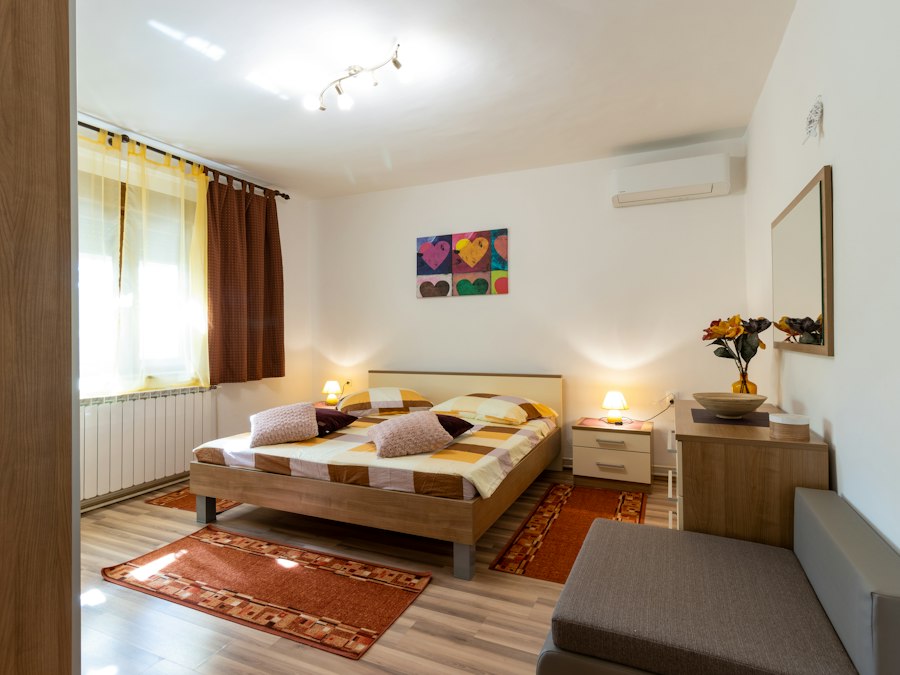The bedroom is a sanctuary, a place where we retreat to relax, unwind, and recharge. It is important to create a space that promotes a sense of calm and tranquility, and one way to achieve this is through proper bedroom lighting Rocalamp. The right lighting can have a significant impact on our mood, productivity, and overall well-being. In this article, we will explore the importance of bedroom lighting and how it can enhance our sleep quality, increase relaxation, and create the perfect ambiance.
Key Takeaways
- Bedroom lighting is important for creating a relaxing atmosphere and performing tasks.
- Types of bedroom lighting include ambient, task, and accent lighting.
- Choosing the right bulbs for your bedroom can affect the mood and energy efficiency.
- Layering your bedroom lighting with different types and sources can create depth and interest.
- Maximizing natural light in your bedroom can improve your mood and save energy.
The Importance of Bedroom Lighting
Proper bedroom lighting is essential for a good night’s sleep. The body’s natural sleep-wake cycle, also known as the circadian rhythm, is influenced by light. Exposure to bright light during the day helps regulate our internal clock and promotes alertness and wakefulness. On the other hand, exposure to dimmer, softer light in the evening signals to our bodies that it is time to wind down and prepare for sleep.
In addition to improving sleep quality, proper bedroom lighting can also enhance relaxation. Soft, warm lighting creates a cozy and inviting atmosphere that promotes relaxation and stress reduction. Harsh, bright lights can be jarring and disrupt the sense of calm that we seek in our bedrooms.
Furthermore, bedroom lighting plays a crucial role in setting the overall ambiance of the space. The right lighting can create a soothing and tranquil environment that promotes rest and rejuvenation. It can also add style and visual interest to the room, making it a more aesthetically pleasing space.
Types of Bedroom Lighting
There are several types of bedroom lighting that can be used to create the desired atmosphere. Overhead lighting is the primary source of light in most bedrooms. It provides general illumination and should be bright enough to navigate the room comfortably but not too harsh or glaring.
Task lighting is another important type of bedroom lighting. It is used for specific activities such as reading or working on a laptop. Task lighting should be focused and adjustable to provide adequate illumination for the task at hand.
Accent lighting is used to highlight specific areas or objects in the room, such as artwork or architectural features. It adds depth and visual interest to the space and can be achieved through the use of wall sconces, pendant lights, or even string lights.
Lastly, natural lighting is an essential element in bedroom design. Maximizing natural light not only reduces the need for artificial lighting during the day but also creates a connection to the outdoors and provides a sense of openness and freshness.
Choosing the Right Bulbs for Your Bedroom
| Factors to Consider | Recommended Bulbs |
|---|---|
| Color Temperature | 2700K-3000K |
| Brightness | 500-1000 lumens |
| Dimmability | Choose bulbs labeled as “dimmable” |
| Energy Efficiency | LED bulbs with ENERGY STAR certification |
| Cost | LED bulbs may have a higher upfront cost but are more cost-effective in the long run |
When choosing bulbs for your bedroom, there are several factors to consider. Color temperature is one of the most important considerations. Warm white or soft white bulbs (around 2700-3000 Kelvin) create a cozy and relaxing atmosphere, while cool white or daylight bulbs (around 5000-6500 Kelvin) mimic natural daylight and promote alertness.
Brightness is another important factor to consider. The right level of brightness will depend on the specific needs of your bedroom. For general illumination, aim for around 1500-3000 lumens. For task lighting, such as reading or working, opt for bulbs with higher lumens (around 400-800 lumens).
Energy efficiency is also an important consideration when choosing bulbs. LED bulbs are the most energy-efficient option and can last up to 25 times longer than traditional incandescent bulbs. They also produce less heat, making them safer and more cost-effective in the long run.
Layering Your Bedroom Lighting
Layering your bedroom lighting involves using multiple light sources to create a balanced and comfortable environment. This technique allows you to adjust the lighting according to your needs and preferences throughout the day.
Start by considering the different types of lighting mentioned earlier – overhead lighting, task lighting, accent lighting, and natural lighting. Each of these types of lighting serves a specific purpose and can be used in combination to create the desired ambiance.
For example, you can use overhead lighting as the primary source of light in the room, supplemented by task lighting for specific activities such as reading or working. Accent lighting can be used to highlight artwork or architectural features, while natural lighting can be maximized during the day to create a bright and airy atmosphere.
Creating a Relaxing Atmosphere with Lighting

Creating a relaxing atmosphere in your bedroom is essential for promoting rest and relaxation. One way to achieve this is through the use of warm, soft lighting. Warm white or soft white bulbs emit a cozy and inviting glow that helps create a sense of calm and tranquility.
Avoid using harsh, bright lights in the bedroom, as they can be jarring and disrupt the relaxation process. Instead, opt for dimmable lights or lamps with adjustable brightness settings. This allows you to customize the lighting according to your needs and create a soothing environment that promotes restful sleep.
Another tip for creating a relaxing atmosphere is to minimize the use of artificial lighting in the evening. Instead, rely on natural light during the day and use blackout curtains or blinds to block out any unwanted light at night. This helps regulate your body’s natural sleep-wake cycle and promotes a more restful night’s sleep.
Adding Task Lighting to Your Bedroom
Task lighting is an important element in bedroom design, especially if you engage in activities such as reading or working in bed. Reading lamps or desk lamps are ideal for providing focused and adjustable lighting for these specific tasks.
When choosing task lighting for your bedroom, consider factors such as brightness and adjustability. Look for lamps with adjustable necks or heads that allow you to direct the light exactly where you need it. Also, consider the color temperature of the bulbs used in task lighting. Warm white or soft white bulbs are generally more suitable for reading or working, as they create a cozy and comfortable environment.
Incorporating Accent Lighting for Style
Accent lighting is a great way to add style and visual interest to your bedroom. It can be used to highlight specific areas or objects in the room, such as artwork, architectural features, or even a statement piece of furniture.
Wall sconces are a popular choice for accent lighting in the bedroom. They can be installed on either side of the bed to create a soft and inviting glow. Pendant lights can also be used as accent lighting, either as a single statement piece or in a cluster to create a dramatic effect.
When incorporating accent lighting into your bedroom, consider the overall style and theme of the room. Choose fixtures that complement the existing decor and enhance the overall aesthetic appeal of the space.
Using Dimmers to Control Your Bedroom Lighting
Dimmer switches are a valuable tool for controlling your bedroom lighting. They allow you to adjust the brightness of your lights according to your needs and preferences, creating a more flexible and customizable environment.
Using dimmers in your bedroom has several benefits. Firstly, they provide increased flexibility in terms of lighting levels. You can easily adjust the brightness of your lights depending on the time of day or the specific activity you are engaged in.
Secondly, dimmers can help save energy and reduce electricity costs. By dimming your lights, you consume less energy and extend the lifespan of your bulbs. This not only benefits the environment but also saves you money in the long run.
Lastly, dimmers can create a more intimate and cozy atmosphere in your bedroom. By lowering the brightness of your lights, you can create a soft and inviting glow that promotes relaxation and restful sleep.
Tips for Maximizing Natural Light in Your Bedroom
Maximizing natural light in your bedroom is not only beneficial for your well-being but also adds a sense of openness and freshness to the space. Here are some tips for maximizing natural light in your bedroom:
1. Use sheer curtains or blinds: Sheer curtains or blinds allow natural light to filter into the room while still providing privacy. They create a soft and diffused glow that adds warmth and brightness to the space.
2. Position furniture strategically: Arrange your furniture in a way that allows for maximum sunlight. Avoid placing large pieces of furniture in front of windows, as they can block the natural light and make the room feel darker and smaller.
3. Use mirrors: Mirrors can help reflect and amplify natural light in your bedroom. Place a mirror opposite a window to bounce light around the room and create a brighter and more spacious feel.
4. Keep windows clean: Dirty windows can obstruct natural light from entering your bedroom. Regularly clean your windows to ensure maximum sunlight and brightness.
5. Consider skylights or light tubes: If possible, consider installing skylights or light tubes in your bedroom. These allow for even more natural light to enter the space and create a connection to the outdoors.
Avoiding Common Lighting Mistakes in Your Bedroom
When it comes to bedroom lighting, there are some common mistakes that should be avoided. One of the most common mistakes is using too many bright lights in the bedroom. Harsh, bright lights can be jarring and disrupt the sense of calm and relaxation that we seek in our bedrooms. Instead, opt for softer, warmer lighting that creates a cozy and inviting atmosphere.
Another common mistake is neglecting to consider the overall ambiance of the room. Lighting should be used to create a balanced and comfortable environment that promotes rest and rejuvenation. Consider layering your lighting, using different types of lighting to create depth and visual interest in the space.
Lastly, it is important to consider the specific needs and preferences of the individuals using the bedroom. Different people have different lighting preferences, so it is important to choose lighting that suits your personal needs and promotes a sense of well-being.
In conclusion, bedroom lighting plays a crucial role in creating a space that promotes relaxation, restful sleep, and overall well-being. The right lighting can enhance our sleep quality, increase relaxation, and create the perfect ambiance. By choosing the right bulbs, layering your lighting, and incorporating different types of lighting, you can create a bedroom that is both functional and aesthetically pleasing. Remember to consider factors such as color temperature, brightness, and energy efficiency when choosing bulbs, and use dimmers to control your lighting levels. By maximizing natural light and avoiding common lighting mistakes, you can create a bedroom that is truly a sanctuary for rest and rejuvenation.
If you’re looking to create the perfect ambiance in your bedroom, lighting plays a crucial role. From bedside lamps to ceiling fixtures, the right lighting can transform your space into a cozy retreat. In fact, studies have shown that the type of lighting in your bedroom can affect your sleep quality and overall well-being. If you’re interested in learning more about how to choose the best lighting for your bedroom, check out this informative article on how a hanging lamp from the 70s adds elegance and sophistication to any home. Discover the different styles and designs available and find inspiration for creating a beautiful and functional bedroom lighting setup.
